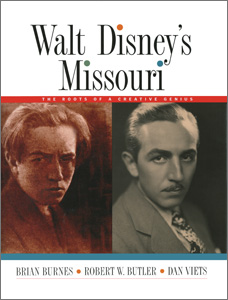|
|||
|
Rocket to the Moon, presented by TWA, opened July 22, 1955. If you need something to celebrate this weekend, how about about the 63rd anniversary of the attraction that wasn’t quite ready on Disneyland ’s opening day? One of my favorite Yesterland articles ever was about two TWA Moonliner rockets a few miles apart. There’s more to the story of TWA and the Moonliner. Dan Viets, who rescued the Moonliner II that had been perched on the TWA Headquarters building in Kansas City from 1956 to 1961, is—not surprisingly—an expert on the Moonliner and its history.
(original version published January 11, 2013) |
|||
|
|
|||
|
“A vista into a world of wondrous ideas, signifying man’s achievements… a step into the future, with predictions of constructive things to come.”
— from Walt Disney’s dedication of Tomorrowland, July 17, 1955 Instead of finding visionary predictions of the future, early Disneyland guests found a so-called Tomorrowland with mainly promotional exhibits, such as the Dutch Boy Paints Color Gallery and the Kaiser Aluminum Hall of Aluminum Fame. Even the Crane Bathroom of Tomorrow, while prominently featuring the word tomorrow in its name, was little more than a chance for children to play with water valves. Sets from the movie 20,000 Leagues Under the Sea filled a large space. That’s not what Walt Disney wanted, but with limited resources, the “predictions of constructive things to come” would, for the most part, have to wait. |
|||
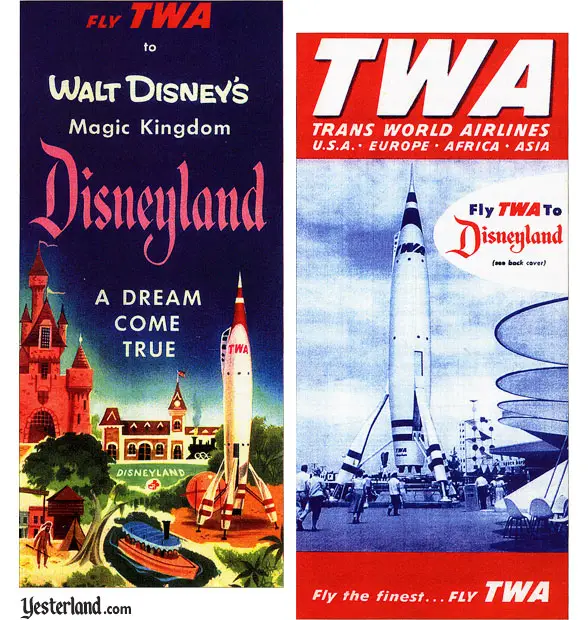
From the collection of Dan Viets © Trans World Airlines and Walt Disney Productions TWA flyers featuring the TWA Moonliner at Disneyland |
|||
|
However, one original 1955 Tomorrowland attraction gave guests the kind of experience that Walt Disney’s dedication promised—Rocket to the Moon, presented by a major airline, TWA. A Disneyland advertising supplement in the Los Angeles Times on July 15, 1955, described the attraction: Welcome aboard Trans World Airlines’ Rocket to the Moon! In Tomorrowland’s world of 1986 you’ll zoom through space at speeds over 172 thousand miles an hour! Actually experience the “feel” of space travel—see Earth below and Heavens above as you pass space station Terra, coast around the Moon and return! An eight-hour flight in ten thrilling minutes—all without ever leaving the ground. The supplement had this to say about the Moonliner: Towering high above all else in Tomorrowland, the 72-foot TWA Moon Rocket symbolizes Trans World Airlines’ interest in future air travel and planned scientific progress. Today, TWA serves 60 U.S. cities, and 21 world centers abroad. |
|||
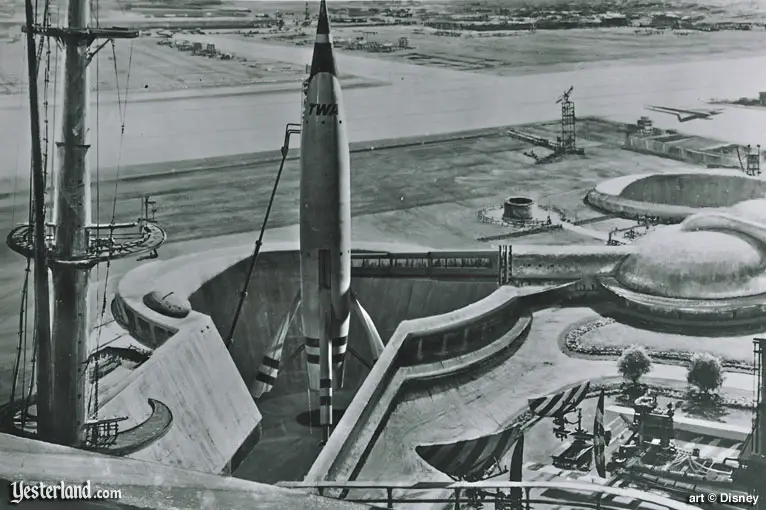
From the collection of Dan Viets Disney artwork from 1955 showing how an actual TWA Moonliner and spaceport might look |
|||
|
Surely, by 1986—the year that Halley’s Comet would return and the year after TWA’s 60th anniversary—TWA would serve not only USA, Europe, Africa, and Asia, but also the Moon. The space flight simulation was primitive by today’s standards, but the concept of commercial passenger travel beyond the atmosphere of Earth was an inspiring vision of things to come. |
|||
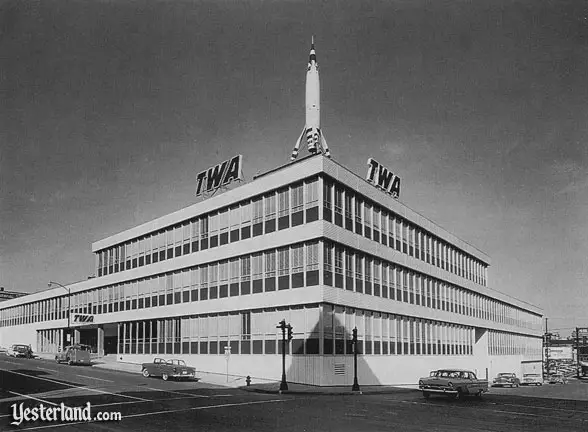
From the collection on Dan Viets, as published in Walt Disney’s Missouri (Kansas City Star Books) TWA Headquarters in Kansas City in the 1950s |
|||
|
Howard Hughes (1905-1976), the majority owner of TWA, was poised to fly his airline to the future. In 1950, without changing the abbreviation, Transcontinental & Western Air had become Trans World Airlines. In 1956, TWA would move into a bold, contemporary headquarters building with a reduced-size replica of the Rocket to the Moon Moonliner on its roof. The same year, TWA would place an order for 63 Convair 880 four-engine jets—faster jetliners than the competing Boeing 707 and Douglas DC-8. (The Convair 880 order would eventually lead to Hughes’ downfall at TWA, but that’s another story.) |
|||
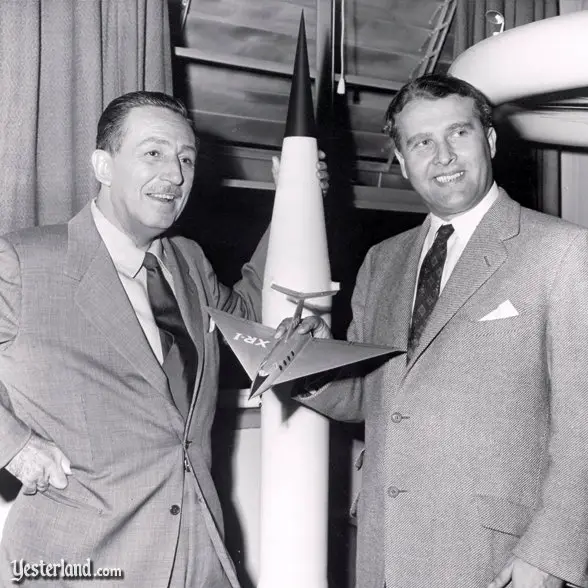
1954 photo from NASA Marshall Space Flight Center Image Archive, MSFC-9132000 Walt Disney with Dr. Wernher von Braun in 1954 |
|||
|
In TWA, Walt Disney had the perfect sponsor for Rocket to the Moon. To design the rocket, Walt turned to artist John Hench, who had worked for him since 1939 and had recently designed the hydraulic giant squid for 20,000 Leagues Under the Sea. Hench worked with rocket scientist Dr. Wernher von Braun to determine what a Moonliner in 1986 would look like and how it would function. At 72 feet tall—80 feet, including its legs—the Disneyland version would be one third the height of what a real Moonliner might be—which still made it taller than the park’s Sleeping Beauty Castle. |
|||
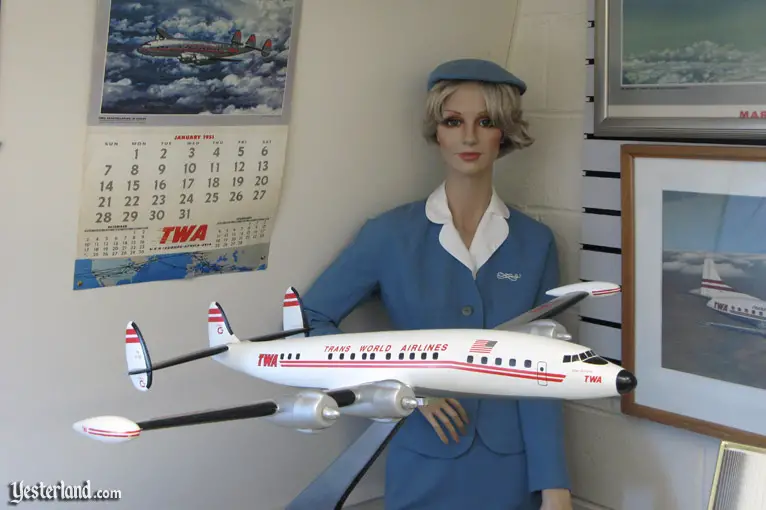
Photo by Werner Weiss, 2010 Model of a Lockheed Super Constellation in an exhibit gallery of the Airline History Museum |
|||
|
There’s a place where you can travel back to the era when the Moonliner was designed. The National Airline History Museum in Kansas City is not only where you’ll find the actual Moonliner II (so dubbed by the late Disney Imagineer/historian Bruce Gordon) that was on the roof of the TWA Headquarters building from 1956 to 1962, it’s also home to a number of beautifully restored airliners, as well as exhibits about the history of airlines and airliners—with a particular emphasis on TWA, long the hometown airline of Kansas City. |
|||
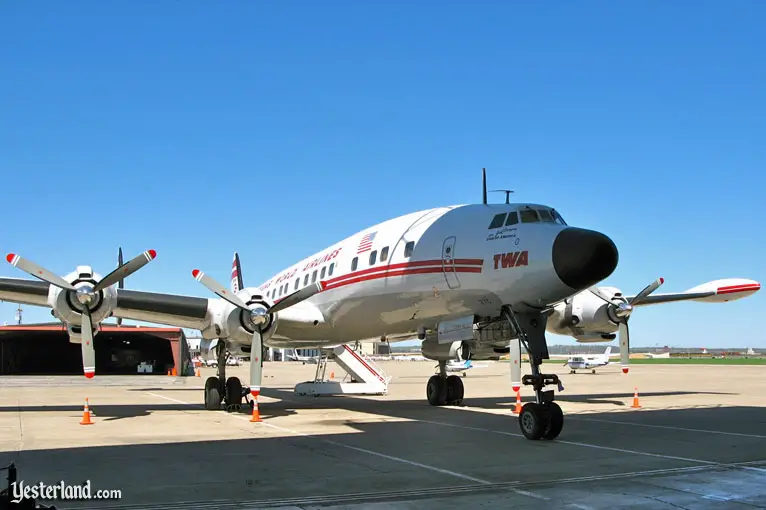
Photo by Werner Weiss, 2010 Lockheed Super G Constellation model L-1049G at the Airline History Museum in Kansas City |
|||
|
Dan Viets describes one of the treasures of the museum’s collection: The Airline History Museum is the home of the Western Hemisphere’s only operational Lockheed Constellation aircraft. The Constellation is noted for being the most beautiful propeller-driven aircraft ever. Howard Hughes purchased a large number of these airplanes to update TWA’s fleet after he acquired the airline. The Connie appeared in many advertisements promoting TWA as “the official airline of Disneyland.” There are travel folders which feature both the Constellation and a prominent image of the TWA Moonliner at Disneyland. In the Martin Scorsese film The Aviator (2004), starring Leonardo DiCaprio as Howard Hughes, the Constellation that DiCaprio appears to pilot is the same one that is in the Airline History Museum. It flew to Los Angeles and back to appear in the film. A short interior scene from Ace Ventura: Pet Detective (1994) was also shot inside the very same aircraft. This Constellation came off Lockheed’s assembly line in 1958—the same year that Boeing and Douglas began building jet airliners. Before being restored, it had been parked in the desert for nine years after its final regular flying role as a bug sprayer in Canada. If you’ve read this far, you’ll now be rewarded with the best part of this article. |
|||
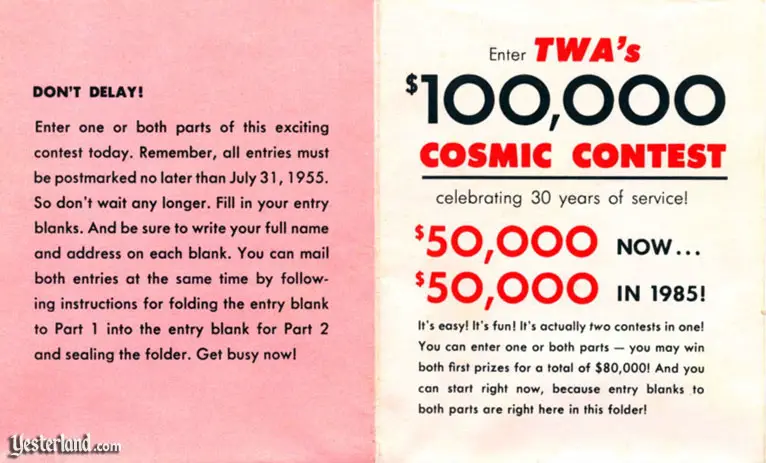
Image from eBay listing 170182113629 © 1955 Trans World Airlines TWA Cosmic Contest entry folder |
|||
|
There was a contest that used the Moonliner II. It led to a remarkable surprise for someone in 1986—the year that the 1955 Tomorrowland was supposed to represent. Dan Viets tells the story: When the Moonliner II was designed, TWA was preparing to celebrate its 30th anniversary. Part of the celebration was the Cosmic Contest, a two-part promotion. The first part of the contest involved inviting TWA passengers to describe why air travel was the best mode of transportation and why TWA was the best airline. The judges of that part of the contest included Wernher von Braun, aviator Jackie Cochran and Walt Disney! They judged the entries and awarded a $50,000 prize to the lucky winner. The second part of the Cosmic Contest was considerably more elaborate. Passengers who boarded TWA’s flights in 1955 were invited to describe what air travel would be like in the distant future of 1985. The entries in that portion of the contest were to be microfilmed and stored in a special “vault” built into the side of the Moonliner II. Indeed, the entries in that portion of the contest did reside in a compartment of the Moonliner while it stood on the roof of the TWA building in Kansas City. When the rocket was removed from the building in 1961, the entries were transferred to a more conventional bank deposit box. In 1986, those entries were reviewed and a winner was chosen. The woman who received a phone call that year from TWA informing her that she had won a contest that she entered 30 years earlier certainly initially thought the phone call was a hoax. However, when the $50,000 check from TWA cleared her bank, she was convinced otherwise! A Houston Chronicle article (“She saw it coming/1955 contest winner predicted air travel of 80s,” Feb. 28, 1986) identified the winner: A Radcliffe-educated octogenarian who correctly foresaw 700 mph aircraft, advanced jet engines and helicopter shuttle service in the 1980s has won $50,000 in Trans World Airlines’ “Cosmic Contest” of 1955. The airline asked customers in 1955 to predict what air travel would be like 30 years in the future. Helen Thomas of Cambridge, Mass., was judged to be the most accurate of 13,000 entrants. “This is a relief and a sublime moment for me,” she said Thursday during an awards ceremony at New York’s Wings Club. Asked what she would do with the money, she said: “Pay taxes and probably take a TWA trip.” Thomas, the first woman in U.S. history to receive a doctorate in the history of science, beat out about 13,000 other entrants from as far away as India in the 1955 contest, which TWA held to celebrate its 30th year of service. Entries were locked in a vault until last year. A San Francisco Chronicle article (“Airline Contest / ‘55 Predictions On ‘85 Travel,” Jan. 1, 1986) described some of the other entries: Thirty years ago, in the propeller-plane days of the 1950s, people entering a contest on the future of air travel imagined atomic-powered planes, flying saucer-shaped aircraft and a helicopter in every garage. One man predicted the atomic destruction of mankind and said only the apes would be left to fly the airplanes. It’s now 2018, and 1986 is farther in the past than it was in the future when Disneyland opened in 1955. We can’t fly to the Moon on any airline (although commercial space flights are now an option for wealthy individuals). We can’t fly anywhere at all on TWA, which went bankrupt and had its assets acquired by American Airlines in 2001. But there was a time before most Yesterland readers were born when people flew to the Moon and back on TWA from Disneyland—and even have the certificate to prove it. |
|||
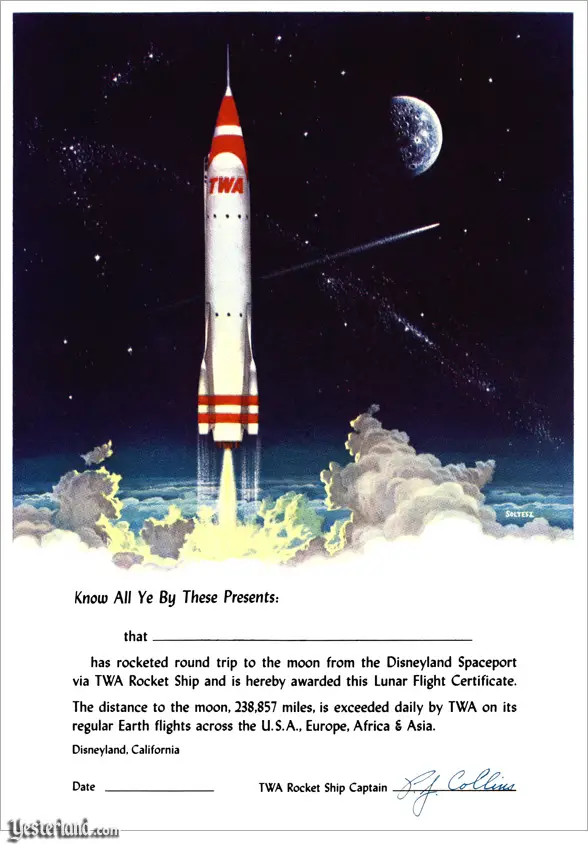
Courtesy Orange County Archives TWA Lunar Flight Certificate from Disneyland in the 1950s |
|||
|
|
|
||
|
|
Click here to post comments at MiceChat about this article.
© 2013-2018 Werner Weiss — Disclaimers, Copyright, and Trademarks Updated July 20, 2018. |
||
